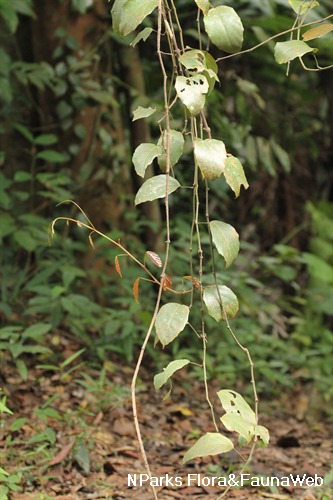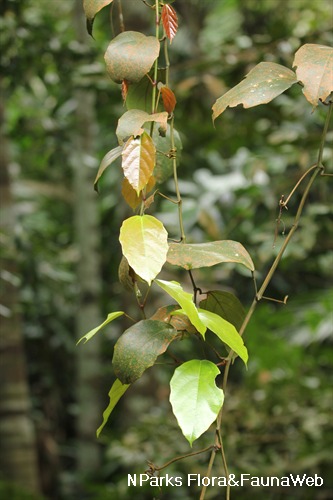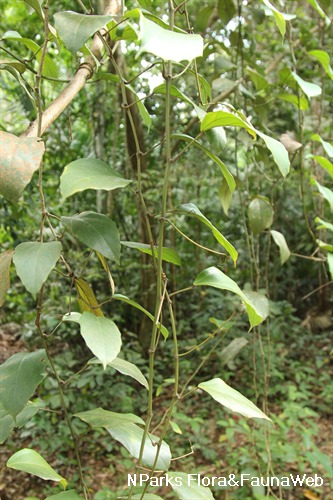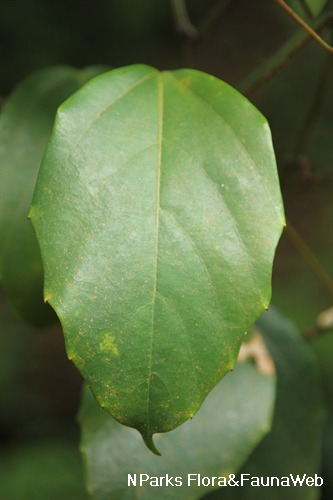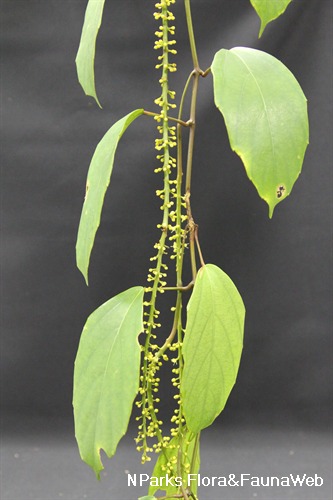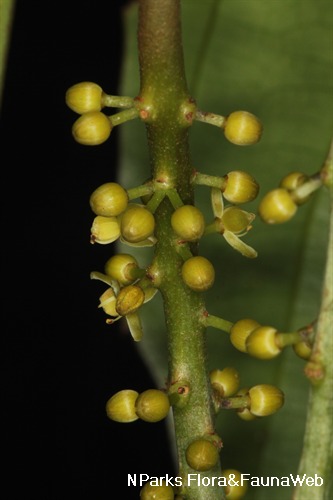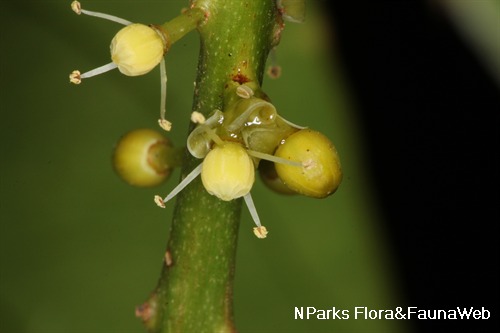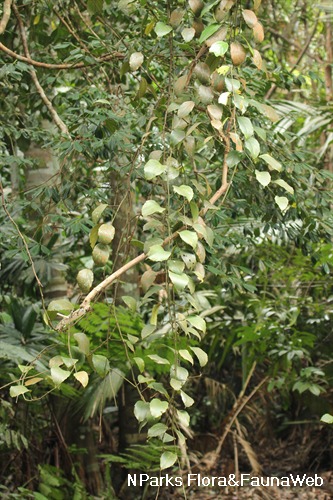
Back
Nothocissus spicifera (Griff.) Latiff
| Family Name: | Vitaceae |
| Synonyms: | Ampelocissus spicifera (Griff.) Planch., Cissus spicifera Griff., Vitis macrostachyus Miq. |
Name
Classifications and Characteristics
| Plant Division | Angiosperms (Flowering Seed Plants) (Dicotyledon) |
|---|---|
| Plant Growth Form | Climber |
| Lifespan (in Singapore) | Perennial |
| Mode of Nutrition | Autotrophic |
Biogeography
| Native Distribution | Peninsular Thailand, Sumatra, Peninsular Malaysia, Singapore, and Borneo |
|---|---|
| Native Habitat | Terrestrial (Primary Rainforest, Secondary Rainforest, Freshwater Swamp Forest, Riverine, Disturbed Area / Open Ground) |
| Preferred Climate Zone | Tropical |
| Local Conservation Status | Native to Singapore (Critically Endangered (CR)) |
Description and Ethnobotany
| Growth Form | It is a woody climber. |
|---|---|
| Foliage | Its alternately arranged, stalked leaves have leathery leaf blades that are simple, broad egg-shaped to oblong, 6–16 by 2–10 cm, and with toothed margins. |
| Flowers | Its stalked flowering shoot is simple or branched, hanging downwards, 40–58 cm long, and found at the end of a shoot. |
| Fruit | Its fruits are round to ellipsoid berries, 15–18 by 8–11 mm, with 1–2 seeds per fruit. Its seeds are up to 12 mm by 6 mm. |
| Habitat | It grows on the fringes and openings of lowland dipterocarp forests and along rivers. It occurs locally along Old Upper Thomson Road, Mandai Road, and the Bukit Timah Nature Reserve. |
| Associated Fauna | Its flowers are pollinated by insects, and its fruits may be eaten and dispersed by birds. |
| Cultivation | It can be propagated by seeds or stem cuttings. |
| Etymology | Greek notho, false; Latin cissus, ivy; Latin spicifera, carrying of the ears of corn or sudden, probably referring to the terminal position of the flowering shoot |
Landscaping Features
| Landscaping | It is suitable for growing in parks and gardens, on trellises and pergolas. |
|---|---|
| Desirable Plant Features | Ornamental Foliage, Ornamental Fruits |
| Landscape Uses | Parks & Gardens, Small Gardens, Trellis / Arbour / Pergola, Riverine |
Fauna, Pollination and Dispersal
| Pollination Method(s) | Biotic (Fauna) |
|---|---|
| Seed or Spore Dispersal | Biotic (Fauna) |
Plant Care and Propagation
| Light Preference | Full Sun, Semi-Shade |
|---|---|
| Water Preference | Lots of Water, Moderate Water |
| Plant Growth Rate | Moderate |
| Rootzone Tolerance | Moist Soils, Well-Drained Soils, Fertile Loamy Soils |
| Transplanting Tolerance | Good |
| Maintenance Requirements | Moderate |
| Propagation Method | Seed, Stem Cutting |
Foliar
| Foliage Retention | Evergreen |
|---|---|
| Mature Foliage Colour(s) | Green |
| Prominent Young Flush Colour(s) | Orange, Red |
| Foliar Type | Simple / Unifoliate |
| Foliar Arrangement Along Stem | Alternate |
| Foliar Attachment to Stem | Petiolate |
| Foliar Shape(s) | Non-Palm Foliage (Ovate, Oblong) |
| Foliar Venation | Pinnate / Net |
| Foliar Margin | Serrate / Toothed |
Floral (Angiosperm)
| Flower & Plant Sexuality | Bisexual Flowers |
| Flower Colour(s) | Green, Yellow / Golden |
|---|---|
| Flower Grouping | Cluster / Inflorescence |
| Flower Location | Axillary |
| Flower Symmetry | Radial |
Fruit, Seed and Spore
| Mature Fruit Colour(s) | Purple |
|---|---|
| Fruit Classification | Simple Fruit |
| Fruit Type | Fleshy Fruit , Non-Accessory Fruit |
Image Repository
Others
| Master ID | 31549 |
|---|---|
| Species ID | 5948 |
| Flora Disclaimer | The information in this website has been compiled from reliable sources, such as reference works on medicinal plants. It is not a substitute for medical advice or treatment and NParks does not purport to provide any medical advice. Readers should always consult his/her physician before using or consuming a plant for medicinal purposes. |

